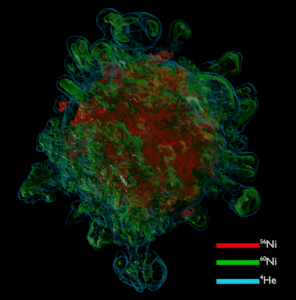The ExaStar project is developing a software ecosystem for exascale architectures that will support world-leading models of the mechanisms and observable consequences of a variety of stellar cataclysms. A multidisciplinary team working with ExaStar’s code suite, a component-based multiphysics toolkit based on the massively parallel adaptive mesh refinement framework AMReX, has introduced improvements that will enable exascale simulations of fundamental astrophysics scenarios, leading to new knowledge of the origins of our galaxy’s heavy elements. Their work was published in July 2021 as a special issue paper in the ECP issue of the International Journal of High Performance Computing Applications.
Current astrophysics models already tax petascale architectures. Realistic exascale astrophysics simulations will require spatial resolutions fine enough to resolve scales of order 100 m within simulations spanning roughly 50,000 km in radius and should evolve nuclear reaction networks with as many as 3,000 isotopes in situ. Computational costs of these simulations will increase by an order of magnitude over petascale calculations, and wall clock time to complete a simulation will need to shorten from the current level of months to weeks. Answering open questions, such as the conditions required for processes that give rise to heavy elements, will require new experimental measurements of highly radioactive isotopes coupled with mature exascale computational models of the potential astrophysical sites. In the case of stellar explosions, the team is targeting ExaStar code suite advancements that enable fully self-consistent calculations of all the main r-process scenarios—core-collapse supernovae, neutron star mergers, and accreting black holes—as well as related stellar explosions including novae, x-ray bursts, and thermonuclear supernovae.
ExaStar’s approach to transitioning astrophysics simulations to the exascale includes substantially increasing the capabilities of two widely used stellar astrophysics codes, FLASH-X and Castro. The researchers have introduced a novel orchestration system that will be used by FLASH-X to balance the competing demands for computing resources between the different parts of the code in a manner that is scalable, portable, and performant. This work represents a crucial step towards establishing a maintainable software ecosystem of unprecedented physical fidelity for exascale and beyond to improve scientific simulations across a variety of architectures.
Ongoing work includes implementing relativistic corrections to the radiation transport code, porting additional microphysics to GPUs, and improving the AMReX framework. Future improvements to ExaStar’s code suite will be facilitated by development of fully functional modular applications.
Harris, J. Austin, Ran Chu, Sean M Couch, Anshu Dubey, Eirik Endeve, Antigoni Georgiadou, Rajeev Jain, Daniel Kasen, M P Laiu, OE B Messer, Jared O’Neal, Michael A Sandoval, and Klaus Weide. “Exascale Models of Stellar Explosions: Quintessential Multi-physics Simulation.” 2021. Special Issue Paper, International Journal of High Performance Computing Applications (July).


